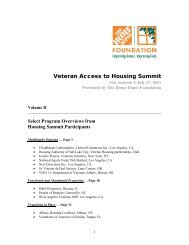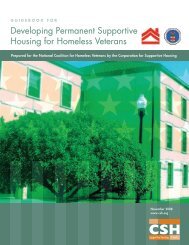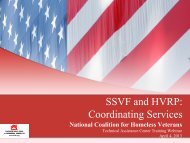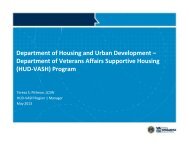Points of Concern in the Five-Year Plan to End Veteran Homelessness
Points of Concern in the Five-Year Plan to End Veteran Homelessness
Points of Concern in the Five-Year Plan to End Veteran Homelessness
Create successful ePaper yourself
Turn your PDF publications into a flip-book with our unique Google optimized e-Paper software.
®<strong>Po<strong>in</strong>ts</strong> <strong>of</strong> <strong>Concern</strong> <strong>in</strong> <strong>the</strong><strong>Five</strong>-<strong>Year</strong> <strong>Plan</strong> <strong>to</strong> <strong>End</strong> <strong>Veteran</strong> <strong>Homelessness</strong>The Service Providers’ Perspective<strong>Concern</strong>s Identified by Service Providers at <strong>the</strong> 2012 NCHV Conference Sessionwith <strong>the</strong> VA Secretary’s Advisory Committee on Homeless <strong>Veteran</strong>sAugust 2012Executive SummaryThe National Coalition for Homeless <strong>Veteran</strong>s (NCHV) held its 15th Annual Conference andMembership Meet<strong>in</strong>g <strong>in</strong> <strong>the</strong> nation’s capital from May 30 through June 1. The event was <strong>the</strong>largest <strong>in</strong> <strong>the</strong> organization’s 22-year his<strong>to</strong>ry, with more than 529 community-based organizationand government agency representatives participat<strong>in</strong>g <strong>in</strong> 38 <strong>in</strong>structional workshops and specialfocus sessions at <strong>the</strong> Grand Hyatt Wash<strong>in</strong>g<strong>to</strong>n.One <strong>of</strong> <strong>the</strong> most talked-about focus sessions <strong>to</strong>ok place on <strong>the</strong> conference’s f<strong>in</strong>al day. Titled“Critical Issues for <strong>the</strong> VA Advisory Committee on Homeless <strong>Veteran</strong>s,” <strong>the</strong> meet<strong>in</strong>g drew morethan 60 service providers and homeless program staff from federal and local levels <strong>of</strong>government. These attendees conveyed <strong>the</strong>ir vary<strong>in</strong>g concerns – cover<strong>in</strong>g policy, program andleadership issues – <strong>to</strong> more than three-quarters <strong>of</strong> <strong>the</strong> VA Secretary’s Advisory Committee,<strong>in</strong>clud<strong>in</strong>g Chairman George Basher, who moderated <strong>the</strong> session.The NCHV Annual Conference kicked <strong>of</strong>f on a note <strong>of</strong> measured optimism. Dur<strong>in</strong>g <strong>the</strong> open<strong>in</strong>gsession, VA Secretary Eric Sh<strong>in</strong>seki <strong>to</strong>ld attendees: “We do have movement, but it’s <strong>to</strong>o early <strong>to</strong>beg<strong>in</strong> ‘high-fiv<strong>in</strong>g’ one ano<strong>the</strong>r. Nei<strong>the</strong>r should any <strong>of</strong> us take a knee as we approach <strong>the</strong> summit.Lean <strong>in</strong><strong>to</strong> <strong>the</strong> hill— keep climb<strong>in</strong>g.”The “Critical Issues” session was notable, <strong>in</strong> part, for its noticeably sharper <strong>to</strong>ne. The open forumfacilitated this by <strong>of</strong>fer<strong>in</strong>g service providers <strong>the</strong> opportunity <strong>to</strong> level criticisms and voice <strong>the</strong>irbiggest concerns <strong>in</strong> <strong>the</strong> company <strong>of</strong> <strong>the</strong>ir peers. A great deal <strong>of</strong> solidarity was realized, and by <strong>the</strong>session’s close, participants deemed that a follow-up report was needed <strong>to</strong> develop <strong>the</strong>ir sharedconcerns.Eighteen primary concerns were identified dur<strong>in</strong>g <strong>the</strong> conference session. This list (available <strong>in</strong>its entirety <strong>in</strong> Appendix A) was distributed <strong>to</strong> session participants who volunteered <strong>to</strong> helpproduce <strong>the</strong> follow-up report. A <strong>to</strong>tal <strong>of</strong> 16 <strong>of</strong> <strong>the</strong>se participants represent<strong>in</strong>g 12 states responded<strong>to</strong> NCHV’s outreach. These respondents categorized <strong>the</strong>ir organizations’ <strong>to</strong>p concerns <strong>in</strong>descend<strong>in</strong>g order.The <strong>to</strong>p seven most-cited concerns by respondents are presented <strong>in</strong> detail <strong>in</strong> this report. Individualsections <strong>of</strong> <strong>the</strong> report were drafted by subgroups <strong>of</strong> different service providers, <strong>the</strong>reby1
epresent<strong>in</strong>g a multitude <strong>of</strong> voices and perspectives. While this approach does not provide ascientific measure <strong>of</strong> <strong>the</strong> issues at hand, it provides a cont<strong>in</strong>uation <strong>of</strong> <strong>the</strong> frank, unprecedenteddiscussion held at <strong>the</strong> NCHV Annual Conference.Most-cited concerns among respondents:1. VA’s long-term plann<strong>in</strong>g <strong>to</strong> serve homeless and at-risk veterans is not properly <strong>in</strong>formedby service providers’ <strong>in</strong>puts. One <strong>of</strong> <strong>the</strong> results <strong>of</strong> this disconnect is that VA policies givemore weight <strong>to</strong> national data than <strong>to</strong> <strong>the</strong> <strong>in</strong>tangibles that add value <strong>to</strong> programs at <strong>the</strong>local level.2. VA’s data on <strong>the</strong> Grant and Per Diem Program (Only 53% <strong>of</strong> participants move <strong>in</strong><strong>to</strong> <strong>the</strong>irown apartment or room upon leav<strong>in</strong>g <strong>the</strong> program.) nei<strong>the</strong>r accurately depicts <strong>the</strong>program’s successes <strong>in</strong> most communities, nor expla<strong>in</strong>s why veterans were not able <strong>to</strong>achieve <strong>in</strong>dependent liv<strong>in</strong>g.3. VA does not contract enough <strong>of</strong> its work with veteran service providers, especially thatwhich focuses on placement <strong>in</strong> permanent hous<strong>in</strong>g.4. Exist<strong>in</strong>g VA performance measures are obstacles <strong>to</strong> accomplish<strong>in</strong>g <strong>the</strong> true goals <strong>of</strong> VA’shomeless programs.5. VA national <strong>of</strong>fices have not successfully communicated with local service providersabout <strong>the</strong> department’s strategies <strong>to</strong> end veteran homelessness.6. HUD-VA Supportive Hous<strong>in</strong>g (HUD-VASH) case management is currently unable <strong>to</strong>address <strong>the</strong> complex needs <strong>of</strong> chronically homeless veterans.7. Homeless women veterans, especially those with military sexual trauma, are likely <strong>to</strong>need more than 90 days <strong>to</strong> stabilize <strong>in</strong> transitional hous<strong>in</strong>g before potentially mov<strong>in</strong>g on<strong>to</strong> <strong>the</strong> HUD-VASH Program.The respondents who helped produce this report cite numerous opportunities for more mean<strong>in</strong>gfulcommunication and collaboration between VA and its community partners. Recommendations for<strong>the</strong>se actions take on multiple forms <strong>in</strong> this report, <strong>in</strong>clud<strong>in</strong>g consultations prior <strong>to</strong> <strong>in</strong>stitut<strong>in</strong>gprogram modifications and issu<strong>in</strong>g fund<strong>in</strong>g notices, and contract<strong>in</strong>g a greater number <strong>of</strong> functions<strong>to</strong> experienced service providers.NCHV presents this document <strong>to</strong> VA Homeless Initiatives leadership <strong>in</strong> hopes that it willillum<strong>in</strong>ate some <strong>of</strong> service providers’ deep-seated concerns, and ultimately re<strong>in</strong>force <strong>the</strong> bondbetween federal and local systems <strong>of</strong> care. We are deeply appreciative <strong>of</strong> all parties <strong>in</strong>volved <strong>in</strong>this project, and dedicated <strong>to</strong> help VA implement and improve <strong>the</strong> <strong>Five</strong>-<strong>Year</strong> <strong>Plan</strong> <strong>to</strong> <strong>End</strong> <strong>Veteran</strong><strong>Homelessness</strong>.2
Participat<strong>in</strong>g organizations and agencies:Representatives from <strong>the</strong> follow<strong>in</strong>g organizations and agencies contributed <strong>to</strong> <strong>the</strong> overall exercisethat produced this report. They are listed alphabetically by <strong>the</strong> states <strong>in</strong> which <strong>the</strong>y areheadquartered:Swords <strong>to</strong> PlowsharesCaliforniaU.S. VETSCalifornia<strong>Veteran</strong>s Village <strong>of</strong> San Diego (VVSD)CaliforniaDenver Human Services, City and County <strong>of</strong> DenverColoradoThe Transition House, Inc.FloridaBoise VA Medical CenterIdahoHoosier <strong>Veteran</strong>s Assistance Foundation (HVAF)IndianaAlliance <strong>Veteran</strong>s Hous<strong>in</strong>g Outreach and Assistance Metro-BaltimoreMaryland<strong>Veteran</strong> Homestead, Inc.MassachusettsM<strong>in</strong>nesota Assistance Council for <strong>Veteran</strong>s (MACV)M<strong>in</strong>nesotaWomen <strong>Veteran</strong>s Assistance and Resource CorporationNew YorkSt. V<strong>in</strong>cent de Paul Society <strong>of</strong> Lane CountyOregonImpact Services CorporationPennsylvaniaPhiladelphia <strong>Veteran</strong>s Multi-Service and Education Center (PVMEC)PennsylvaniaCenter for <strong>Veteran</strong>s IssuesWiscons<strong>in</strong>3
<strong>Concern</strong> #1VA’s long-term plann<strong>in</strong>g <strong>to</strong> serve homeless and at-risk veterans is notproperly <strong>in</strong>formed by service providers’ <strong>in</strong>puts. One <strong>of</strong> <strong>the</strong> results <strong>of</strong> thisdisconnect is that VA policies give more weight <strong>to</strong> national data than <strong>to</strong> <strong>the</strong><strong>in</strong>tangibles that add value <strong>to</strong> programs at <strong>the</strong> local level.Explanation:Service providers generally agree that hous<strong>in</strong>g, employment and health care alone cannottransition a veteran from homelessness <strong>to</strong> stability. Effective program design is a comb<strong>in</strong>ation <strong>of</strong><strong>the</strong>se elements, <strong>in</strong>tended <strong>to</strong> take advantage <strong>of</strong> <strong>the</strong> capacities <strong>of</strong> community-based organizationsand collaboration with local resources. Restrictive timeframes and fund<strong>in</strong>g categorizationsestablished at <strong>the</strong> national level limit service providers <strong>in</strong> <strong>the</strong>ir ability <strong>to</strong> provide <strong>the</strong> trulycomprehensive service that is necessary <strong>to</strong> help each veteran transition successfully. Propertreatment takes time and <strong>of</strong>ten multiple resources and <strong>in</strong>terventions for effective rehabilitationand re<strong>in</strong>tegration.Too many policy decisions, <strong>in</strong>clud<strong>in</strong>g grant awards, are based strictly on <strong>the</strong> numbers. While<strong>the</strong>se outcome measures are certa<strong>in</strong>ly crucial for evaluat<strong>in</strong>g programs, <strong>the</strong> data lacks specificdetails that expla<strong>in</strong> why <strong>the</strong>y are effective or not. The VA’s data on <strong>the</strong> Grant and Per Diem(GPD) Program – that only 53% <strong>of</strong> participants move <strong>in</strong><strong>to</strong> <strong>the</strong>ir own apartment or room uponleav<strong>in</strong>g <strong>the</strong> program – is a good example. This data nei<strong>the</strong>r accurately depicts <strong>the</strong> program’ssuccesses <strong>in</strong> most communities nor expla<strong>in</strong>s why veterans are not able <strong>to</strong> achieve <strong>in</strong>dependentliv<strong>in</strong>g.A dramatic shift <strong>in</strong> strategy without <strong>in</strong>put from successful programs can have a tremendousimpact on <strong>the</strong> veteran. For example, many <strong>of</strong> <strong>the</strong> community-based organizations (CBOs) thatnow operate successful GPD programs may not have <strong>the</strong> capacity or <strong>the</strong> local resources <strong>to</strong>effectively operate a Transition <strong>in</strong> Place program. Due <strong>to</strong> limited hous<strong>in</strong>g s<strong>to</strong>ck <strong>in</strong> many areas,CBOs may require capital grants <strong>to</strong> br<strong>in</strong>g a traditional GPD hous<strong>in</strong>g unit up <strong>to</strong> Department <strong>of</strong>Hous<strong>in</strong>g and Urban Development (HUD) standards for permanent hous<strong>in</strong>g <strong>in</strong> order <strong>to</strong> make thismodel practical. Without capital fund<strong>in</strong>g, <strong>the</strong> shift <strong>to</strong> this model could feasibly elim<strong>in</strong>ate qualityservices for thousands <strong>of</strong> homeless veterans.Ano<strong>the</strong>r example <strong>of</strong> <strong>the</strong> concern cited above: Categorical spend<strong>in</strong>g restrictions <strong>in</strong> <strong>the</strong> SupportiveServices for <strong>Veteran</strong> Families (SSVF) Program grant has actually made it easier for veterans <strong>in</strong>some areas <strong>to</strong> become homeless <strong>in</strong> order <strong>to</strong> become re-housed than it is <strong>to</strong> keep <strong>the</strong> person <strong>in</strong>hous<strong>in</strong>g. This, <strong>in</strong> effect, creates homelessness <strong>in</strong> order <strong>to</strong> cure it. Conversations with serviceproviders could help <strong>to</strong> solve this contradic<strong>to</strong>ry practice.Recommendation:Instead <strong>of</strong> conclud<strong>in</strong>g that a program is fail<strong>in</strong>g <strong>to</strong> produce <strong>the</strong> desired numerical outcomesnationally, <strong>the</strong> VA needs more discrete data, <strong>in</strong>dicat<strong>in</strong>g which <strong>of</strong> its programs are work<strong>in</strong>g sothose models can be supported and replicated, and which <strong>of</strong> its programs are underperform<strong>in</strong>g so<strong>the</strong>y can be re-evaluated and potentially elim<strong>in</strong>ated. In this way, we would build on <strong>the</strong> strengths<strong>of</strong> <strong>the</strong> GPD program, ra<strong>the</strong>r than relegat<strong>in</strong>g and disparag<strong>in</strong>g <strong>the</strong> whole program.4
The local providers are <strong>the</strong> experts when it comes <strong>to</strong> identify<strong>in</strong>g regional capacities for services,as well as identify<strong>in</strong>g those services that produce quality results. Numbers alone don’t reflect <strong>the</strong>service <strong>to</strong> <strong>the</strong> veteran. Organizational “best practices” should be shared across provider networks,both regionally and nationally, and those best practices should <strong>in</strong>clude peer provider <strong>in</strong>put. Peerreview comb<strong>in</strong>ed with cus<strong>to</strong>mer feedback regard<strong>in</strong>g <strong>the</strong>se services is essential <strong>to</strong> ensur<strong>in</strong>g thateffective organizations, and effective programs, are awarded fund<strong>in</strong>g. In <strong>the</strong> spirit <strong>of</strong> <strong>in</strong>teragencycollaboration, <strong>the</strong> <strong>in</strong>put <strong>of</strong> local organizations provid<strong>in</strong>g services <strong>to</strong> homeless veterans and <strong>the</strong>irevaluation <strong>of</strong> what works <strong>in</strong> <strong>the</strong>ir communities should carry significant weight <strong>in</strong> both policy andgrant-award decisions.<strong>End</strong><strong>in</strong>g homelessness among veterans is a noble goal and a vision through which every serviceprovider should direct <strong>the</strong>ir services. However, as most service providers are acutely aware, <strong>the</strong>problem <strong>of</strong> homelessness does not have a “silver bullet” solution that can be directed from <strong>the</strong>highest levels. What works <strong>in</strong> one region <strong>of</strong> <strong>the</strong> country may not work <strong>in</strong> ano<strong>the</strong>r. Similarly, whatworks <strong>in</strong> one region <strong>of</strong> a state may not work <strong>in</strong> ano<strong>the</strong>r. National policies <strong>of</strong>ten obscure variablesthat are important at <strong>the</strong> local level. Accord<strong>in</strong>gly, national policies should create a frameworkwith<strong>in</strong> which <strong>the</strong>re exists flexibility <strong>to</strong> address local issues.<strong>Concern</strong> #2VA’s data on <strong>the</strong> Grant and Per Diem Program (Only 53% <strong>of</strong> participantsmove <strong>in</strong><strong>to</strong> <strong>the</strong>ir own apartment or room upon leav<strong>in</strong>g <strong>the</strong> program.) nei<strong>the</strong>raccurately depicts <strong>the</strong> program’s successes <strong>in</strong> most communities nor expla<strong>in</strong>swhy veterans are not able <strong>to</strong> achieve <strong>in</strong>dependent liv<strong>in</strong>g.Explanation:The GPD Program is not and has never been a “Hous<strong>in</strong>g First” program. Based on <strong>the</strong> currentprogram description, “The purpose is <strong>to</strong> promote <strong>the</strong> development and provision <strong>of</strong> supportivehous<strong>in</strong>g and/or supportive services with <strong>the</strong> goal <strong>of</strong> help<strong>in</strong>g homeless veterans achieve residentialstability, <strong>in</strong>crease <strong>the</strong>ir skill levels and/or <strong>in</strong>come, and obta<strong>in</strong> greater self-determ<strong>in</strong>ation.” TheGPD Program is not and should not be evaluated based upon a Hous<strong>in</strong>g First philosophy. Ra<strong>the</strong>r,<strong>the</strong> GPD Program provides “a transition” from homelessness <strong>to</strong> a stable way <strong>of</strong> life. Many <strong>of</strong> <strong>the</strong>current GPD programs are highly successful at help<strong>in</strong>g homeless veterans achieve stability <strong>in</strong><strong>the</strong>ir lives— stability def<strong>in</strong>ed as much by a job or <strong>in</strong>creas<strong>in</strong>g skill levels as by achiev<strong>in</strong>gpermanent hous<strong>in</strong>g.Should <strong>the</strong> GPD Program be reformed? Yes.Should <strong>the</strong> GPD Program be rigorously evaluated? Yes.Should GPD providers be accountable <strong>to</strong> standards set by <strong>the</strong> VA for program performance? Yes.But please do not throw <strong>the</strong> baby out with <strong>the</strong> bathwater. Every year s<strong>in</strong>ce its found<strong>in</strong>g <strong>the</strong> GPDProgram has helped thousands <strong>of</strong> homeless veterans <strong>to</strong> stabilize <strong>the</strong>ir lives. This most <strong>of</strong>ten<strong>in</strong>cludes provid<strong>in</strong>g veterans with a place <strong>to</strong> live while <strong>the</strong>y work on <strong>the</strong>ir recovery from drug andalcohol addiction, mental health issues, employment problems, and f<strong>in</strong>d<strong>in</strong>g and ma<strong>in</strong>ta<strong>in</strong><strong>in</strong>gpermanent hous<strong>in</strong>g.5
Recommendation:A study should be immediately commissioned on <strong>the</strong> current success <strong>of</strong> <strong>the</strong> GPD Program basedon its current (non-Hous<strong>in</strong>g First) guidel<strong>in</strong>es. This study should <strong>in</strong>clude statements by formerlyhomeless veterans about <strong>the</strong> impact GPD has had on <strong>the</strong>ir lives. F<strong>in</strong>ally, this study should featurecase studies describ<strong>in</strong>g NCHV member organizations that operate successful GPD programs.Clearly stated program objectives and guidel<strong>in</strong>es for <strong>the</strong> GPD Program should be developed at anational level, and <strong>the</strong>se objectives and guidel<strong>in</strong>es should be <strong>in</strong>stituted and evaluated rigorouslyover <strong>the</strong> next three years. Poorly perform<strong>in</strong>g programs should be de-funded and successfulprograms should be supported and ma<strong>in</strong>ta<strong>in</strong>ed.In addition, <strong>the</strong> supply <strong>of</strong> permanent supportive hous<strong>in</strong>g could and should be greatly <strong>in</strong>creased byfund<strong>in</strong>g project-based HUD-VA Supportive Hous<strong>in</strong>g (HUD-VASH) vouchers, which can beawarded <strong>to</strong> developers <strong>of</strong> affordable hous<strong>in</strong>g for homeless veterans early <strong>in</strong> a developmentprocess that can take up <strong>to</strong> four years. Awards <strong>of</strong> project-based HUD-VASH vouchers should becont<strong>in</strong>gent upon <strong>the</strong> award <strong>of</strong> Low Income Hous<strong>in</strong>g Tax Credits for development, thus leverag<strong>in</strong>g<strong>the</strong> operat<strong>in</strong>g support.<strong>Concern</strong> #3VA does not contract enough <strong>of</strong> its work with veteran service providers,especially that which focuses on hous<strong>in</strong>g.A. Opportunities <strong>to</strong> contract case management servicesExplanation:Community-based service providers have many <strong>of</strong> <strong>the</strong> skills, resources and relationshipsnecessary <strong>to</strong> implement programs that VA tries <strong>to</strong> implement <strong>in</strong>-house. They possess uniqueknowledge <strong>of</strong> <strong>the</strong> hous<strong>in</strong>g and social service landscapes <strong>in</strong> <strong>the</strong>ir communities. VA’s <strong>in</strong>ternaliz<strong>in</strong>gapproach, however, <strong>of</strong>ten delays <strong>the</strong> implementation <strong>of</strong> critical programs due <strong>to</strong> hir<strong>in</strong>g needs and<strong>the</strong> learn<strong>in</strong>g curve for new and <strong>in</strong>experienced staff.The HUD-VASH Program provides an example <strong>of</strong> this phenomenon. Instead <strong>of</strong> contract<strong>in</strong>g outcase management <strong>to</strong> service providers or <strong>in</strong>dependent contrac<strong>to</strong>rs, VA decided <strong>to</strong> hire socialworkers from with<strong>in</strong> its mental health system. This delayed program implementation and resulted<strong>in</strong> under-assigned units <strong>to</strong> <strong>the</strong> chronically homeless population. As a result, Congress questioneddemand for <strong>the</strong> program, lead<strong>in</strong>g <strong>to</strong> some mismatch <strong>in</strong> <strong>the</strong> subsequent allocation <strong>of</strong> vouchers. Thetrue demand <strong>in</strong> a given area for <strong>the</strong>se vouchers may not have been reflected due <strong>to</strong> <strong>the</strong> delay <strong>in</strong>hir<strong>in</strong>g social workers, caused by VA’s <strong>in</strong>ternalization.This approach impacts veterans directly as well. In one major city, two HUD-VASH casemanagers have been assigned <strong>to</strong> work with 50 project-based tenants as well as all scattered-sitetenants <strong>in</strong> <strong>the</strong> community, giv<strong>in</strong>g <strong>the</strong>m caseloads <strong>of</strong> more than 50 veterans each. When immediate<strong>in</strong>tervention is needed for <strong>the</strong>se veterans, <strong>the</strong>ir case managers <strong>of</strong>ten are not available. Propertystaff and local nonpr<strong>of</strong>it service providers are left <strong>to</strong> provide assistance and prevent eviction,6
although <strong>the</strong>y are not be<strong>in</strong>g reimbursed for furnish<strong>in</strong>g <strong>the</strong>se services. These issues are even morepronounced <strong>in</strong> rural areas.Several o<strong>the</strong>r areas and programs would benefit from contract<strong>in</strong>g with VA, <strong>in</strong>clud<strong>in</strong>g <strong>the</strong>Readjustment Counsel<strong>in</strong>g Service (RCS) Program, <strong>the</strong> delivery mental health services, hous<strong>in</strong>gspecialists, and employment tra<strong>in</strong><strong>in</strong>g and assistance.Recommendation:By contract<strong>in</strong>g HUD-VASH case management <strong>to</strong> local nonpr<strong>of</strong>its – those with culturalcompetence and experience work<strong>in</strong>g with veterans – VA could improve <strong>the</strong> case managementratio, thus provid<strong>in</strong>g more comprehensive services <strong>to</strong> veterans <strong>in</strong> <strong>the</strong> program. The recentlyenacted Public Law No. 112-154 states that <strong>the</strong> VA Secretary “shall consider enter<strong>in</strong>g <strong>in</strong><strong>to</strong>contracts or agreements” <strong>in</strong> <strong>the</strong> provision <strong>of</strong> HUD-VASH case management but makes norequirement for him <strong>to</strong> do so.Additionally, VA must consider <strong>the</strong> range and severity <strong>of</strong> issues for <strong>in</strong>dividual HUD-VASHclients when assign<strong>in</strong>g case managers <strong>the</strong>ir caseloads. Case managers must be able <strong>to</strong> provideadequate care <strong>to</strong> <strong>the</strong> veterans who have been entrusted <strong>to</strong> <strong>the</strong>m.B. Overlap <strong>of</strong> employment services for homeless veteransExplanation:In early 2011, <strong>the</strong> <strong>Veteran</strong>s Health Adm<strong>in</strong>istration (VHA) hired 21 full-time employees across <strong>the</strong>country for <strong>the</strong> new Homeless <strong>Veteran</strong> Supported Employment Program (HVSEP), designed <strong>to</strong>improve employment outcomes for homeless and at-risk veterans. This did not appear <strong>to</strong> becoord<strong>in</strong>ated with <strong>the</strong> Department <strong>of</strong> Labor-<strong>Veteran</strong>s’ Employment and Tra<strong>in</strong><strong>in</strong>g Service (DOL-VETS), which adm<strong>in</strong>isters <strong>the</strong> Homeless <strong>Veteran</strong>s Re<strong>in</strong>tegration Program (HVRP).Our organization heard about HVSEP one day when <strong>the</strong> program’s new case manager <strong>in</strong>troducedhimself <strong>in</strong> a meet<strong>in</strong>g and said, “I help homeless veterans get employed.” My HVRP casemanagers were more than perplexed by this.If <strong>the</strong>se positions had been placed on VHA campuses with no HVRP grantees <strong>in</strong> <strong>the</strong> surround<strong>in</strong>garea, <strong>the</strong>n <strong>the</strong> HVSEP rollout might have made sense. In most cases unfortunately, <strong>the</strong>se positionswere co-located <strong>in</strong> communities with HVRP grantees. Most <strong>of</strong> us still do not understand exactlyhow <strong>to</strong> <strong>in</strong>terface with <strong>the</strong>se positions without appear<strong>in</strong>g <strong>to</strong> compete for numbers and confuse <strong>the</strong>veteran about who is <strong>the</strong>ir employment case manager.Why didn’t VA refer homeless veterans <strong>to</strong> HVRP programs and save fund<strong>in</strong>g on HVSEPpositions? Was <strong>the</strong>re some def<strong>in</strong>ed gap that HVRP grantees were not fill<strong>in</strong>g? The answers <strong>to</strong><strong>the</strong>se questions rema<strong>in</strong> unclear.As an HVRP and SSVF grantee, <strong>of</strong> course we have reached out <strong>to</strong> our HVSEP counterparts andare attempt<strong>in</strong>g coord<strong>in</strong>ation, but we still do not see <strong>the</strong> driv<strong>in</strong>g need for this program. If we hadbeen asked <strong>to</strong> collaborate early on, we could have streng<strong>the</strong>ned <strong>the</strong> design <strong>of</strong> HVSEP and enabledit <strong>to</strong> enhance what we do as HVRP grantees. We would have welcomed this, especially s<strong>in</strong>ce ourHVRP grant caps have rema<strong>in</strong>ed constant for years.7
Recommendation:If <strong>the</strong>re was truly a def<strong>in</strong>ed gap that HVRP grantees were not fill<strong>in</strong>g, VA could have contracted orestablished agreements with experienced community-based service providers <strong>to</strong> perform thiswork.At present, coord<strong>in</strong>ation may take precedence over contract<strong>in</strong>g. Best practices <strong>of</strong> both HVRP andHVSEP should be highlighted <strong>to</strong> allow VA and its community partners <strong>to</strong> make <strong>the</strong> most <strong>of</strong> <strong>the</strong>seresources and m<strong>in</strong>imize any duplication <strong>of</strong> effort.<strong>Concern</strong> #4Exist<strong>in</strong>g VA performance measures are obstacles <strong>to</strong> accomplish<strong>in</strong>g <strong>the</strong> truegoals <strong>of</strong> VA’s homeless programs.A. Consequences <strong>of</strong> a restricted “homeless” def<strong>in</strong>itionExplanation:One serious concern regard<strong>in</strong>g performance measures as obstacles <strong>to</strong> accomplish<strong>in</strong>g <strong>the</strong> true goals<strong>of</strong> VA’s homeless programs is <strong>the</strong> def<strong>in</strong>ition <strong>of</strong> homelessness. The SSVF Program has beenpromoted extensively as a prevention program. However, <strong>the</strong> limited amount <strong>of</strong> temporaryf<strong>in</strong>ancial assistance (TFA) directed <strong>to</strong>wards prevention is a barrier <strong>to</strong> keep<strong>in</strong>g veteran familiesfrom becom<strong>in</strong>g homeless. This will be exacerbated by a more restrictive homeless def<strong>in</strong>ition <strong>in</strong><strong>the</strong> upcom<strong>in</strong>g grant cycle, which VA has stated that it will use.Currently, <strong>the</strong> follow<strong>in</strong>g groups are considered homeless for <strong>the</strong> purposes <strong>of</strong> TFA: veteranfamilies that are doubled up and must leave that situation with<strong>in</strong> 14 days or will lose <strong>the</strong>irhous<strong>in</strong>g; veterans <strong>in</strong> transitional hous<strong>in</strong>g; or veterans who are o<strong>the</strong>rwise homeless under <strong>the</strong>HEARTH Act def<strong>in</strong>ition. By restrict<strong>in</strong>g <strong>the</strong> def<strong>in</strong>ition <strong>of</strong> “homeless,” many veterans will nolonger be homeless— not because <strong>the</strong>ir emergent crises have been resolved, but because <strong>the</strong>irsituations have been redef<strong>in</strong>ed. It seems this move is driven by performance measures, as veterans<strong>in</strong> shelters or counted <strong>in</strong> unsheltered counts are easier <strong>to</strong> measure.In many rural areas, <strong>the</strong>re are no shelters for miles, and many rural areas have cold w<strong>in</strong>ters thatprohibit veteran families from camp<strong>in</strong>g or liv<strong>in</strong>g <strong>in</strong> vehicles. These veterans are much more likely<strong>to</strong> be doubled up out <strong>of</strong> necessity— yet <strong>the</strong>ir family’s situation is no more stable than that <strong>of</strong>veterans with shelter that is available <strong>in</strong> urban areas. VA’s data seems <strong>to</strong> be driv<strong>in</strong>g policy ashomeless veterans who are more difficult <strong>to</strong> count are redef<strong>in</strong>ed out <strong>of</strong> homelessness, whileveterans who can be more easily re-housed are emphasized <strong>to</strong> prop up <strong>the</strong> department’s dataoutl<strong>in</strong><strong>in</strong>g its reduction <strong>of</strong> homelessness.The SSVF Program is <strong>of</strong>ten portrayed as a much-needed prevention resource. Yet <strong>in</strong> practice, <strong>the</strong>program has steered away from that emphasis by limit<strong>in</strong>g <strong>the</strong> percentage <strong>of</strong> TFA available forhomelessness prevention. In most cases, prevention is <strong>the</strong> least expensive and best option for aveteran family. It costs less than pay<strong>in</strong>g mov<strong>in</strong>g fees and security deposits, and is cheaper (from<strong>the</strong> locality’s perspective) than a shelter stay. It is best for households with children so that <strong>the</strong>ycan avoid be<strong>in</strong>g uprooted and experience homelessness. In many communities, especially those <strong>in</strong>8
ural areas, <strong>the</strong>re may not be available affordable hous<strong>in</strong>g with<strong>in</strong> a school district, caus<strong>in</strong>g evenmore upheaval <strong>in</strong> <strong>the</strong> lives <strong>of</strong> veterans’ families.It seems aga<strong>in</strong> that <strong>the</strong> move away from prevention is due <strong>to</strong> <strong>the</strong> lack <strong>of</strong> effective ways <strong>to</strong> capturedata show<strong>in</strong>g that prevention methods effectively prevent homelessness. By redef<strong>in</strong><strong>in</strong>g rapid rehous<strong>in</strong>g,VA is putt<strong>in</strong>g a greater burden on <strong>the</strong> already-<strong>to</strong>o-th<strong>in</strong>ly stretched TFA resourcesallowable for prevention. The department’s performance measure is based on what can becounted, not on address<strong>in</strong>g <strong>the</strong> way <strong>to</strong> create <strong>the</strong> most effective outcome for veteran families.Recommendation:A primary corrective action for this situation would be <strong>to</strong> let service providers use <strong>the</strong> entireHEARTH Act def<strong>in</strong>ition <strong>of</strong> homelessness. It is difficult <strong>to</strong> expla<strong>in</strong> <strong>to</strong> a veteran family <strong>of</strong> four,whose cous<strong>in</strong> has allowed <strong>the</strong>m <strong>to</strong> stay <strong>in</strong> her liv<strong>in</strong>g room for a week, or whose landlord hasgiven <strong>the</strong>m three days <strong>to</strong> pack and move, that <strong>the</strong>y are not homeless. By utiliz<strong>in</strong>g <strong>the</strong> fullHEARTH Act def<strong>in</strong>ition, resources will be more readily available for this family. By allow<strong>in</strong>gmore TFA <strong>to</strong> be spent <strong>to</strong>ward prevention, perhaps this family could avoid leav<strong>in</strong>g <strong>the</strong>ir orig<strong>in</strong>alresidence <strong>in</strong> <strong>the</strong> first place.By cont<strong>in</strong>u<strong>in</strong>g <strong>to</strong> look closely at SSVF providers’ service records and hous<strong>in</strong>g stability andsupportive service plans, VA can ensure that <strong>the</strong> program’s funds are not be<strong>in</strong>g used only forthose easiest <strong>to</strong> serve, but for those <strong>in</strong> crisis situations without resources and support. This willallow us <strong>to</strong> truly address VA Secretary Eric Sh<strong>in</strong>seki’s mission <strong>to</strong> end veteran homelessness.B. Performance measures can be weakened by VA culture and at times seem <strong>in</strong>compatible withcerta<strong>in</strong> realitiesExplanation:Performance measures established by VA are <strong>of</strong>ten driven by its culture. As observed by thiswriter over many years, that culture has been one <strong>of</strong> <strong>in</strong>ternal program development; <strong>in</strong>ternaldecision mak<strong>in</strong>g; and <strong>in</strong>ternal adm<strong>in</strong>istration <strong>to</strong> address issues affect<strong>in</strong>g <strong>the</strong> veteran population, asopposed <strong>to</strong> collaboration with service providers, consensus-build<strong>in</strong>g among stakeholders andsolicit<strong>in</strong>g broad <strong>in</strong>put from <strong>the</strong> field. Address<strong>in</strong>g veterans’ issues <strong>in</strong>ternally could be consideredcommendable for a federal agency because it demonstrates its concern for a targeted population.But due <strong>to</strong> <strong>the</strong> layers <strong>of</strong> bureaucracy with<strong>in</strong> VA, <strong>the</strong> flexibility and nimbleness <strong>in</strong> decisionmak<strong>in</strong>gthat is <strong>of</strong>ten required <strong>to</strong> assist veterans is sacrificed.One example <strong>of</strong> VA performance measures be<strong>in</strong>g weakened by <strong>the</strong> department’s culture is <strong>the</strong>recent tighten<strong>in</strong>g <strong>of</strong> GPD rules that apply <strong>to</strong> female veterans over safety concerns. The concernfor this population’s safety and security is commendable. However, implementation <strong>of</strong> somemeasures lacked thoughtful <strong>in</strong>put from service providers, and may negatively affect <strong>the</strong>socialization processes needed by some female veterans <strong>to</strong> fully re<strong>in</strong>tegrate back <strong>in</strong><strong>to</strong> ma<strong>in</strong>streamsociety. Additionally, by isolat<strong>in</strong>g females from services be<strong>in</strong>g provided at a gender-neutrallocation, organizations may be forced <strong>to</strong> take on <strong>in</strong>creased costs <strong>to</strong> provide <strong>the</strong> same services on agender-specific basis. As a result, new performance measures related <strong>to</strong> female veterans willnegatively affect <strong>the</strong> ability <strong>of</strong> service providers <strong>to</strong> stabilize homeless female veterans and place<strong>the</strong>m <strong>in</strong><strong>to</strong> permanent hous<strong>in</strong>g.9
Some VA performance measures, meanwhile, simply do not make sense. For example, if aveteran dies while he or she is <strong>in</strong> <strong>the</strong> program, this is considered a negative outcome, thusskew<strong>in</strong>g <strong>the</strong> numbers. Similarly, if a veteran is hospitalized for more than three days, <strong>the</strong> veteranis discharged from <strong>the</strong> program and this is considered a negative outcome. If he or she is releasedfrom <strong>the</strong> hospital any day after be<strong>in</strong>g discharged, <strong>the</strong> veteran must be re-entered <strong>in</strong><strong>to</strong> <strong>the</strong> programor released on<strong>to</strong> <strong>the</strong> street, <strong>in</strong> many cases nullify<strong>in</strong>g weeks or months <strong>of</strong> progress.Recommendation:Some cite national data as show<strong>in</strong>g that transitional supportive hous<strong>in</strong>g has poor results.However, if we look deeper <strong>in</strong><strong>to</strong> <strong>the</strong> numbers, we see that some opera<strong>to</strong>rs have excellen<strong>to</strong>utcomes while o<strong>the</strong>rs do not. We cannot base national, blanket programm<strong>in</strong>g on <strong>the</strong>se numbersalone.This goes directly <strong>to</strong> <strong>the</strong> po<strong>in</strong>t that positive outcomes require collaborative plann<strong>in</strong>g and local<strong>in</strong>put. With this <strong>in</strong>put, VA should be able <strong>to</strong> readily address questions such as <strong>the</strong> follow<strong>in</strong>g:• Does <strong>the</strong> GPD Program work <strong>in</strong> community X and not community Y?• Can or should VA or its contrac<strong>to</strong>rs provide technical assistance <strong>to</strong> <strong>the</strong> GPD provider <strong>in</strong>Community X?• Should VA pull fund<strong>in</strong>g from specific providers?Accord<strong>in</strong>gly, VA should re-evaluate its <strong>in</strong>ternal culture, recogniz<strong>in</strong>g that many issues are betteraddressed on an outsourced basis with performance measures relat<strong>in</strong>g <strong>to</strong> goal atta<strong>in</strong>ment.Nimbleness and responsiveness with<strong>in</strong> a broad framework <strong>of</strong> performance measures are <strong>the</strong> keys<strong>to</strong> success.<strong>Concern</strong> #5VA national <strong>of</strong>fices have not successfully communicated with local serviceproviders about <strong>the</strong> department’s strategies <strong>to</strong> end veteran homelessness.A. Community plann<strong>in</strong>g should be more <strong>in</strong>clusiveExplanation:After receiv<strong>in</strong>g criticism from community-based service providers about <strong>the</strong> lack <strong>of</strong> opportunitiesfor <strong>in</strong>put, VA made a national push <strong>to</strong> have m<strong>in</strong>i “summits” at each VA medical center (VAMC).Many <strong>of</strong> <strong>the</strong>se summits were not plann<strong>in</strong>g sessions, but ra<strong>the</strong>r three-hour <strong>in</strong>formation sessionswithout any opportunities for actual community <strong>in</strong>put <strong>in</strong><strong>to</strong> VAMCs’ respective five-year plans,nor any vett<strong>in</strong>g <strong>of</strong> those plans once <strong>the</strong>y were developed.Additionally, CBOs were bl<strong>in</strong>dsided by a decrease <strong>in</strong> GPD applications and an emphasis onTransition <strong>in</strong> Place (TIP) without recognition <strong>of</strong> <strong>the</strong> f<strong>in</strong>ancial risk associated with exist<strong>in</strong>g plansor <strong>the</strong> viability <strong>of</strong> <strong>the</strong> TIP model <strong>in</strong> high-cost hous<strong>in</strong>g markets or areas with highly vulnerableclients.10
One NCHV member who attended <strong>the</strong> “Critical Issues” conference session provided <strong>the</strong>follow<strong>in</strong>g testimony:“S<strong>in</strong>ce we were unaware <strong>of</strong> <strong>the</strong> pend<strong>in</strong>g changes dur<strong>in</strong>g <strong>the</strong> past two years, our agencyraised millions <strong>of</strong> dollars <strong>of</strong> local construction fund<strong>in</strong>g <strong>to</strong> house and serve homelessveterans with <strong>the</strong> expectation that <strong>the</strong> VA would provide us <strong>the</strong> opportunity <strong>to</strong> competefor operat<strong>in</strong>g fund<strong>in</strong>g <strong>in</strong> 2011 and 2012. While <strong>the</strong> merits <strong>of</strong> <strong>the</strong> new TIP program aredebatable, <strong>the</strong> poor communication from <strong>the</strong> VA <strong>to</strong> providers seems beyond dispute.”The lack <strong>of</strong> collaboration with CBOs has led <strong>to</strong> much unease and confusion with regard <strong>to</strong> <strong>the</strong>transition <strong>to</strong> a TIP model. Many members object <strong>to</strong> a freeze <strong>in</strong> GPD fund<strong>in</strong>g and fear it will beslashed. O<strong>the</strong>rs embrace <strong>the</strong> TIP model but believe that it is contra<strong>in</strong>dicated for <strong>the</strong> mostvulnerable veterans, who will fall back <strong>in</strong><strong>to</strong> chronic homelessness, and for those who havechalleng<strong>in</strong>g transitional obstacles. For example, homeless women veterans, especially those withmilitary sexual trauma, are likely <strong>to</strong> need more time <strong>to</strong> stabilize <strong>in</strong> transitional hous<strong>in</strong>g beforepotentially mov<strong>in</strong>g on <strong>to</strong> <strong>the</strong> HUD-VASH Program.We recognize that <strong>Veteran</strong>s Integrated Service Networks (VISNs) and VAMCs have a lot <strong>of</strong>au<strong>to</strong>nomy <strong>in</strong> adm<strong>in</strong>ister<strong>in</strong>g programs <strong>in</strong> <strong>the</strong>ir localities. Such au<strong>to</strong>nomy is necessary <strong>to</strong> addressunique local challenges—local employment rates, hous<strong>in</strong>g s<strong>to</strong>ck, available services, etc.However, VA has not engaged <strong>in</strong> true community plann<strong>in</strong>g <strong>in</strong> <strong>the</strong> development <strong>of</strong> <strong>the</strong> <strong>Five</strong>-<strong>Year</strong><strong>Plan</strong> <strong>to</strong> <strong>End</strong> <strong>Veteran</strong> <strong>Homelessness</strong>.Recommendation:VA should br<strong>in</strong>g community partners <strong>to</strong> <strong>the</strong> table, <strong>in</strong>clud<strong>in</strong>g exist<strong>in</strong>g opera<strong>to</strong>rs, local governmenthous<strong>in</strong>g and behavioral health policy and program staff, and <strong>the</strong> Cont<strong>in</strong>uum <strong>of</strong> Care (CoC). Thesepartners have <strong>the</strong> experience and local knowledge <strong>to</strong> most appropriately deploy resources <strong>in</strong> <strong>the</strong>irlocalities. National staff should be present <strong>in</strong> <strong>the</strong>se discussions <strong>to</strong> ensure that relevant local fac<strong>to</strong>rsare <strong>in</strong>corporated <strong>in</strong><strong>to</strong> national strategic plann<strong>in</strong>g. In this way, local issues are addressed, <strong>the</strong>duplication <strong>of</strong> services is reduced, and exist<strong>in</strong>g (non-VA) government, corporate and nonpr<strong>of</strong>itresources are leveraged.Fur<strong>the</strong>rmore, we suggest <strong>the</strong> national VA mandate a progress report from VAMCs or VISNs <strong>to</strong>gauge <strong>the</strong> results <strong>of</strong> true community plann<strong>in</strong>g processes. This report should <strong>in</strong>clude an analysis <strong>of</strong>local challenges; an assessment <strong>of</strong> <strong>the</strong> local deployment <strong>of</strong> relatively new programs, <strong>in</strong>clud<strong>in</strong>gSSVF and HUD-VASH; and a revision or approval <strong>of</strong> <strong>the</strong> exist<strong>in</strong>g strategies as <strong>in</strong>formed by thisanalysis and assessment. This process should require VA <strong>to</strong> work with <strong>the</strong> community <strong>of</strong> veteranhous<strong>in</strong>g opera<strong>to</strong>rs where <strong>the</strong>y exist; full participation <strong>of</strong> CoCs; and, where <strong>the</strong>y exist, regionalsteer<strong>in</strong>g committees on homelessness and poverty <strong>to</strong> ensure that homeless assistance plans areharmonious and best leverage community and federal resources while respond<strong>in</strong>g <strong>to</strong> local needs.Recent “rapid results boot camps,” supported by national HUD and VA <strong>in</strong> 15 cities, illustrate <strong>the</strong>fact that challenges <strong>in</strong> deployment <strong>of</strong> federal resources vary considerably by locality, call<strong>in</strong>g forlocally generated solutions. It is only through <strong>in</strong>corporat<strong>in</strong>g all relevant stakeholders at <strong>the</strong> locallevel that efforts <strong>to</strong> end veteran homelessness will succeed.Local providers should be <strong>in</strong>cluded <strong>in</strong> conversations before VA national <strong>of</strong>fices publish <strong>the</strong>irRequest for Proposals (RFP) design, eligibility and report<strong>in</strong>g requirements. Incorporat<strong>in</strong>g <strong>the</strong>experience <strong>of</strong> local providers who actively work <strong>in</strong> <strong>the</strong> field, assess needs and implementsolutions would make <strong>the</strong> requirements more realistic with<strong>in</strong> <strong>the</strong> context <strong>of</strong> each community.11
An ombudsman or arbitration process on <strong>the</strong> VA federal level is ano<strong>the</strong>r potential solution <strong>to</strong> help<strong>in</strong>stitutionalize coord<strong>in</strong>ation between and among community-based service providers, local VAfacilities and national VA programmatic leadership.B. Discern<strong>in</strong>g <strong>the</strong> differences between dataExplanation:Some NCHV members have reported that <strong>the</strong>y pay little attention <strong>to</strong> <strong>the</strong> VA’s Project CHALENG(Community <strong>Homelessness</strong> Assessment, Local Education and Network<strong>in</strong>g Groups) report as itdoes not mean<strong>in</strong>gfully collect or analyze its survey data. VA’s overall measurement <strong>of</strong> veteranhomelessness, meanwhile, mischaracterizes <strong>the</strong> reality <strong>in</strong> some communities. An NCHV memberwho attended <strong>the</strong> “Critical Issues” conference session stated <strong>the</strong> follow<strong>in</strong>g: “We are constantly<strong>to</strong>ld that <strong>the</strong> numbers <strong>of</strong> veterans who are homeless is drastically decreas<strong>in</strong>g. Here at ground zero,all our beds are occupied and we have a wait<strong>in</strong>g list <strong>of</strong> over 75 veterans just wait<strong>in</strong>g for anopportunity <strong>to</strong> enter our programs.”Recommendation:A “weight fac<strong>to</strong>r” could be applied <strong>to</strong> reports submitted <strong>to</strong> VA. For example, <strong>the</strong> first question for<strong>the</strong> CHALENG report could read: “In <strong>the</strong> past year, how many homeless veterans and familymembers have you provided services <strong>to</strong>?” If one organization served 2,000 homeless veterans andano<strong>the</strong>r organization served 200, this ratio should be taken <strong>in</strong> <strong>to</strong> consideration. Many <strong>of</strong> <strong>the</strong> VA’sstatistics are reported <strong>in</strong> percentages. Ten percent <strong>of</strong> 2,000 is obviously a lot more than 10 percent<strong>of</strong> 200. This would establish a reality <strong>to</strong> <strong>the</strong> numbers and give a more adequate picture <strong>of</strong> <strong>the</strong> “on<strong>the</strong>-ground”issues fac<strong>in</strong>g providers and homeless veterans and <strong>the</strong>ir families.C. Community engagement around permanent supportive hous<strong>in</strong>g modelsExplanation:Many service providers report that “Hous<strong>in</strong>g First” models are highly effective and immediatelysolve <strong>the</strong> homelessness issue on a particular day. Yet those organizations that work with a largenumber <strong>of</strong> homeless veterans know that <strong>the</strong> key <strong>to</strong> hous<strong>in</strong>g is <strong>to</strong> ensure it is affordable, safe andma<strong>in</strong>ta<strong>in</strong>able. If <strong>the</strong> veteran is unable <strong>to</strong> keep his or her hous<strong>in</strong>g because <strong>of</strong> substance abuse,mental health issues or o<strong>the</strong>r issues, it just doesn’t work. Warehous<strong>in</strong>g <strong>the</strong>m without appropriatesupportive services sets <strong>the</strong>m up for failure, which may, at a later date, cause additional barriers<strong>to</strong> hous<strong>in</strong>g and employment. It may look good on paper <strong>to</strong> permanently house a veteran with<strong>in</strong> 90days or so. But if <strong>the</strong> veteran is only able <strong>to</strong> stay <strong>in</strong> his or her new apartment until <strong>the</strong> rent is due,this does little <strong>to</strong> solve <strong>the</strong> issues and barriers confront<strong>in</strong>g him or her. Rehabilitation proceduresand employment issues can sometimes take a long time <strong>to</strong> resolve.Recommendation:Environmental fac<strong>to</strong>rs associated with <strong>the</strong> provision <strong>of</strong> supportive hous<strong>in</strong>g vary a great dealacross this country. Without engag<strong>in</strong>g local governments, community providers and CoCs <strong>in</strong> <strong>the</strong>plann<strong>in</strong>g process, federal resources are poorly deployed, fail<strong>in</strong>g <strong>to</strong> leverage <strong>the</strong> local resourcesand expertise necessary <strong>to</strong> meet <strong>the</strong> goal <strong>of</strong> end<strong>in</strong>g veteran homelessness <strong>in</strong> specific communities.12
In terms <strong>of</strong> permanent supportive hous<strong>in</strong>g, scattered-site HUD-VASH vouchers may be ideal forrelatively stable veterans and may even be a path out <strong>of</strong> supportive hous<strong>in</strong>g <strong>to</strong> <strong>in</strong>dependent liv<strong>in</strong>g.For many, however, <strong>in</strong>clud<strong>in</strong>g our ag<strong>in</strong>g veterans and those with serious or co-occurr<strong>in</strong>gdisabilities, it is much more <strong>of</strong> a challenge. In those cases, site-based HUD-VASH would providea dignified, safe environment.<strong>Concern</strong> #6HUD-VA Supportive Hous<strong>in</strong>g (HUD-VASH) case management is currentlyunable <strong>to</strong> address <strong>the</strong> complex needs <strong>of</strong> chronically homeless veterans.A. The HUD-VASH Program should <strong>of</strong>fer veterans stronger opportunities <strong>to</strong> rise out <strong>of</strong> povertyand provide case managers with real-life experienceExplanation:The current problems with HUD-VASH result from mis<strong>in</strong>formation and poor tra<strong>in</strong><strong>in</strong>g. It isdifficult for anyone <strong>to</strong> get copies <strong>of</strong> <strong>the</strong> actual program manual from HUD, and different hous<strong>in</strong>gauthorities have different <strong>in</strong>terpretations <strong>of</strong> regulations. Responsibility for <strong>the</strong> vouchers isconstantly be<strong>in</strong>g transferred from <strong>to</strong>wn <strong>to</strong> <strong>to</strong>wn, and no one seems <strong>to</strong> know what is go<strong>in</strong>g on.While some VA staffers work effectively, <strong>the</strong> department tends <strong>to</strong> pile more work on <strong>the</strong>m <strong>in</strong>particular, caus<strong>in</strong>g eventual burn out.Case managers for <strong>the</strong> most part are poorly tra<strong>in</strong>ed and very <strong>in</strong>experienced. Young, mostly femalecollege graduates know what is <strong>in</strong> <strong>the</strong> book, but <strong>the</strong>y have no real-life experience and are taskedwith visit<strong>in</strong>g <strong>the</strong> residents. In most cases, this works out <strong>to</strong> about one visit every four weeks— ifthat. No one is even sure what it is that <strong>the</strong>y do.Ano<strong>the</strong>r problem noticed by our organization is that <strong>the</strong> HUD-VASH Program keeps people atpoverty level. If you have children and want <strong>to</strong> save for education, or if you would like <strong>to</strong> save fora home, it is not possible. As soon as you have 10 dollars over <strong>the</strong> cut<strong>of</strong>f numbers, you lose <strong>the</strong>voucher.Hous<strong>in</strong>g courts vary from state <strong>to</strong> state, and most small programs can’t afford lawyers <strong>to</strong> handleevictions while HUD-VASH residents are destroy<strong>in</strong>g <strong>the</strong> hous<strong>in</strong>g provided <strong>to</strong> <strong>the</strong>m through <strong>the</strong>program. When a resident decides <strong>to</strong> s<strong>to</strong>p pay<strong>in</strong>g his or her share <strong>of</strong> <strong>the</strong> rent, <strong>the</strong> program is stuckwith <strong>the</strong> problems. This creates a f<strong>in</strong>ancial handicap for <strong>the</strong> program, and is problematic forlandlords as well.Recommendation:First, VA needs <strong>to</strong> admit that young people just out <strong>of</strong> college have not hit <strong>the</strong> learn<strong>in</strong>g curve withsubstance abuse. Both VA and HUD should develop an easy-<strong>to</strong>-read curriculum expla<strong>in</strong><strong>in</strong>g <strong>the</strong>rules and implications <strong>of</strong> <strong>the</strong> HUD-VASH Program, and how this relates <strong>to</strong> substance issues. Thisshould be used by <strong>the</strong> cities and <strong>to</strong>wns that are responsible for issu<strong>in</strong>g vouchers as well.13
Second, <strong>the</strong> HUD-VASH Program needs more support for scenarios when residents refuse <strong>to</strong> pay<strong>the</strong>ir portion <strong>of</strong> <strong>the</strong> rent. Tak<strong>in</strong>g away <strong>the</strong> voucher is one step, but <strong>the</strong>n <strong>the</strong> program is left with acourt case and f<strong>in</strong>ancial issues. Many landlords will not take HUD-VASH vouchers any longerdue <strong>to</strong> <strong>the</strong>se issues. An enforcement process must be established.Third, <strong>the</strong>re should not be a penalty on families try<strong>in</strong>g <strong>to</strong> save for a goal. These families should beallowed <strong>to</strong> earmark an account for college funds or <strong>to</strong> secure hous<strong>in</strong>g.B. Scattered-site HUD-VASH has drawbacks for case managementExplanation:The HUD-VASH case management model traditionally used by VA is not a Hous<strong>in</strong>g First modeland is <strong>the</strong>refore <strong>in</strong>sufficient and <strong>in</strong>effective with chronically homeless and mentally ill veterans.Hous<strong>in</strong>g First is ideal for <strong>the</strong>se populations because it requires little from <strong>the</strong> participants,wrapp<strong>in</strong>g services around <strong>the</strong>m <strong>to</strong> create stability and help <strong>the</strong>m progress <strong>to</strong> <strong>in</strong>dependent liv<strong>in</strong>g.The HUD-VASH case management model, however, assigns one case manager <strong>to</strong> at least 25clients, <strong>of</strong>ten <strong>in</strong> scattered-site hous<strong>in</strong>g. The best a case manager can hope <strong>to</strong> do is <strong>to</strong>uch a clientfor one hour once a month— as cited by dozens <strong>of</strong> VA case workers around <strong>the</strong> country.Chronically homeless and mentally ill veterans cannot hope <strong>to</strong> achieve stability with such limitedcontact. Experience shows that given <strong>the</strong>se conditions, <strong>the</strong>y deteriorate rapidly and end up los<strong>in</strong>g<strong>the</strong>ir HUD-VASH vouchers <strong>to</strong> eviction. This is not helpful for <strong>the</strong> veteran or <strong>the</strong> system <strong>of</strong> carethat works so hard <strong>to</strong> get <strong>the</strong>se veterans <strong>of</strong>f <strong>the</strong> streets.Recommendation:Project-bas<strong>in</strong>g HUD-VASH has <strong>the</strong> potential <strong>to</strong> be a positive solution <strong>to</strong> this dilemma. If youhave 50 <strong>of</strong> <strong>the</strong>se tenants <strong>in</strong> a build<strong>in</strong>g, two case managers can share an <strong>of</strong>fice and be available ona daily basis <strong>to</strong> set up regular appo<strong>in</strong>tments, coord<strong>in</strong>ate groups, develop community resources,and respond <strong>to</strong> crises. However, <strong>the</strong> experience <strong>of</strong> hous<strong>in</strong>g developers with project-basedvouchers has been anyth<strong>in</strong>g but effective.In one major city, an <strong>of</strong>fice for HUD-VASH case managers has rema<strong>in</strong>ed unoccupied for months.When <strong>the</strong> program liaison was recently called by <strong>the</strong> hous<strong>in</strong>g developer, <strong>the</strong> voice mailbox wasfull and not accept<strong>in</strong>g messages. Case managers tend not <strong>to</strong> answer <strong>the</strong>ir phones after hours andon weekends when emergencies <strong>of</strong>ten arise for veterans with more serious problems.One Sunday morn<strong>in</strong>g, one <strong>of</strong> <strong>the</strong>se veterans jumped <strong>to</strong> his death after try<strong>in</strong>g <strong>to</strong> reach his casemanager. Property staff and local nonpr<strong>of</strong>it service provider staff were on site with<strong>in</strong> half an hourand rema<strong>in</strong>ed <strong>the</strong>re <strong>in</strong><strong>to</strong> <strong>the</strong> night <strong>to</strong> work with <strong>the</strong> veterans. VA staff did not return phone calls.<strong>Concern</strong> #7Homeless women veterans, especially those with military sexual trauma, arelikely <strong>to</strong> need more than 90 days <strong>to</strong> stabilize <strong>in</strong> transitional hous<strong>in</strong>g beforepotentially mov<strong>in</strong>g on <strong>to</strong> <strong>the</strong> HUD-VASH Program.14
A. Consultations should be held <strong>to</strong> determ<strong>in</strong>e if <strong>the</strong> 90-day threshold is sufficientExplanation:The <strong>to</strong>tal dis<strong>in</strong>tegration <strong>of</strong> <strong>the</strong> “Hous<strong>in</strong>g Ready” model could well be an outcome <strong>of</strong> <strong>the</strong> Hous<strong>in</strong>gFirst model. Many believe this must be avoided <strong>in</strong> order <strong>to</strong> truly address <strong>the</strong> needs <strong>of</strong> all veterans,o<strong>the</strong>rwise we are requir<strong>in</strong>g all homeless veterans <strong>to</strong> meet a pre-determ<strong>in</strong>ed, <strong>in</strong>flexible, unrealisticset <strong>of</strong> goals and ultimately deny<strong>in</strong>g <strong>the</strong>m <strong>the</strong> opportunity <strong>to</strong> reach atta<strong>in</strong>able and successfulpermanent hous<strong>in</strong>g.VA Secretary Eric Sh<strong>in</strong>seki has stated that no door out <strong>of</strong> homelessness should be elim<strong>in</strong>ated.There cont<strong>in</strong>ues <strong>to</strong> be a need for a variety <strong>of</strong> entry po<strong>in</strong>ts <strong>to</strong> <strong>in</strong>dependent hous<strong>in</strong>g, and a true<strong>in</strong>dividualized assessment <strong>of</strong> capabilities should be utilized <strong>in</strong> order <strong>to</strong> produce <strong>the</strong> mostsuccessful outcomes for our veterans.In <strong>the</strong> HUD-VASH Program, a veteran’s complexity and severity <strong>of</strong> need—debt, safety, medicaland mental health issues—are <strong>in</strong>dividually addressed by case managers and cl<strong>in</strong>ical staff. Theprogram’s policy that veterans should not receive vouchers if <strong>the</strong>y have resided <strong>in</strong> a transitionalfacility for more than 90 days is extremely shortsighted.These veterans’ issues are <strong>of</strong> such a magnitude that <strong>the</strong>y <strong>of</strong>ten require more than 90 days <strong>to</strong>resolve. This is especially true for veterans who have been homeless for an extended period, carrydebilitat<strong>in</strong>g debt, or have serious mental health issues. Any GPD service provider can attest <strong>to</strong>this and provide specific documentation <strong>of</strong> this reality. This 90-day rul<strong>in</strong>g elim<strong>in</strong>ates someveterans from access <strong>to</strong> <strong>the</strong> HUD-VASH Program, which was designed <strong>to</strong> br<strong>in</strong>g advantage <strong>to</strong><strong>the</strong>m.Sexual trauma is a situation <strong>of</strong> a devastat<strong>in</strong>g degree. In fiscal year (FY) 2011, <strong>the</strong> Department <strong>of</strong>Defense reported 3,192 reports <strong>of</strong> sexual assault, up one percent from FY 2010. The departmentestimates that one <strong>in</strong> five women and one <strong>in</strong> 100 men are affected, approximat<strong>in</strong>g that more than19,000 were raped or assaulted <strong>in</strong> 2010. The U.S. Military Academies report an <strong>in</strong>crease <strong>in</strong> <strong>the</strong>se<strong>in</strong>cidents <strong>of</strong> 63 percent for FY 2011 over FY 2010. This is not affect<strong>in</strong>g only women— accord<strong>in</strong>g<strong>to</strong> <strong>the</strong> VA, 45.7 percent <strong>of</strong> veterans who screened positive for military sexual trauma (MST) <strong>in</strong>2010 were men and 39 percent <strong>of</strong> veterans receiv<strong>in</strong>g MST treatment were men.It has been identified that women veterans have a high <strong>in</strong>cidence <strong>of</strong> sexual assault, childhoodsexual assault and trauma, domestic violence, and MST. With <strong>the</strong>se issues alone comes <strong>the</strong>burden <strong>of</strong> address<strong>in</strong>g <strong>the</strong> mental health/psychiatric diagnoses that <strong>in</strong>terfere with <strong>the</strong>ir very ability<strong>to</strong> function. Many live <strong>in</strong> <strong>the</strong> dark places <strong>of</strong> shame and guilt that can at times be paralyz<strong>in</strong>g.Self-harm is also a reality for many <strong>of</strong> <strong>the</strong>se women. One GPD women veterans program reportsthat <strong>of</strong> <strong>the</strong> 205 women admitted, specific mental health conditions were present <strong>in</strong> <strong>the</strong> follow<strong>in</strong>gpercentages:• Military sexual trauma – 44 percent• Sexual trauma – 54 percent• Childhood abuse – 55 percent• Domestic violence – 53 percent• Non-combat PTSD – 46 percent• Bipolar disorder – 31 percent15
• Depressive disorder – 57 percent• Self-harm – 19 percent• Personality disorder – 11 percent• Adjustment disorder – 6 percent• Schizophrenia – 8 percentThese women are <strong>of</strong>ten debilitated <strong>to</strong> <strong>the</strong> po<strong>in</strong>t <strong>of</strong> requir<strong>in</strong>g <strong>the</strong>rapy several times a week, andneed admission <strong>to</strong> a VA residential <strong>in</strong>tensive <strong>the</strong>rapeutic program specializ<strong>in</strong>g <strong>in</strong> MST beforereturn<strong>in</strong>g <strong>to</strong> GPD Program <strong>to</strong> treat <strong>the</strong>ir o<strong>the</strong>r outstand<strong>in</strong>g problems. All <strong>of</strong> this <strong>in</strong>dividualizedassistance for successful community <strong>in</strong>tegration can take longer than 90 days. Truthfully, <strong>the</strong> VAis <strong>of</strong>ten not staffed <strong>to</strong> provide <strong>the</strong> level <strong>of</strong> case management that <strong>the</strong> veteran will require <strong>in</strong> order<strong>to</strong> ma<strong>in</strong>ta<strong>in</strong> and susta<strong>in</strong> <strong>in</strong>dependent liv<strong>in</strong>g.Recommendation:Many GPD service providers feel that more <strong>of</strong> <strong>the</strong>ir feedback and suggestions should beconsidered <strong>in</strong> <strong>the</strong> process <strong>of</strong> sett<strong>in</strong>g VA policy that affects <strong>the</strong> veterans with whom <strong>the</strong>y areentrusted. We certa<strong>in</strong>ly realize <strong>the</strong> importance <strong>of</strong> studies and data, but <strong>the</strong>se are statistics withoutnames or emotions or <strong>the</strong> scars <strong>of</strong> life. If attention isn’t given <strong>to</strong> <strong>the</strong> uniqueness <strong>of</strong> <strong>the</strong> <strong>in</strong>dividual,we have, <strong>in</strong> a way, dehumanized him or her as a statistic <strong>in</strong> a column on a page <strong>in</strong> a book.HUD-VASH case managers should confer with local GPD program direc<strong>to</strong>rs and case workers, <strong>in</strong>concert with <strong>the</strong> veteran’s mental health cl<strong>in</strong>ician, <strong>to</strong> determ<strong>in</strong>e if that veteran is appropriate forhous<strong>in</strong>g before 90 days.Push<strong>in</strong>g <strong>the</strong> veteran out before he or she is reasonably capable <strong>of</strong> surviv<strong>in</strong>g <strong>in</strong> <strong>the</strong> community isonly sett<strong>in</strong>g <strong>the</strong>m up for failure. This serves no one— least <strong>of</strong> all <strong>the</strong> veteran, who ends up back <strong>in</strong><strong>the</strong> system aga<strong>in</strong>.B. Thoroughly deal<strong>in</strong>g with women vets’ trauma can compound o<strong>the</strong>r time-consum<strong>in</strong>g issuesExplanation:In our area, many <strong>of</strong> <strong>the</strong> women need multiple services, and coord<strong>in</strong>at<strong>in</strong>g and attend<strong>in</strong>g <strong>the</strong>variety <strong>of</strong> referrals, consults and needed appo<strong>in</strong>tments takes time. Until <strong>the</strong>y receive <strong>the</strong>seservices, many <strong>of</strong> <strong>the</strong>se women are not ready <strong>to</strong> transition out <strong>of</strong> <strong>the</strong> structured environmentprovided by transitional hous<strong>in</strong>g. Also, many <strong>of</strong> our female veterans are <strong>in</strong>volved <strong>in</strong> multipletreatment programs with a list <strong>of</strong> requirements and time-sensitive goals. Be<strong>in</strong>g an <strong>in</strong>dividualsuffer<strong>in</strong>g most <strong>of</strong>ten with a mental illness, substance abuse disorder, socialization issues,budget<strong>in</strong>g issues, estrangement, etc. and try<strong>in</strong>g <strong>to</strong> attend <strong>the</strong> multiple, varied weekly appo<strong>in</strong>tmentswhile complet<strong>in</strong>g required paperwork for each type <strong>of</strong> appo<strong>in</strong>tment <strong>in</strong>creases stress and reducesmotivation <strong>to</strong> move forward.These women can become even more overwhelmed <strong>in</strong> <strong>the</strong> beg<strong>in</strong>n<strong>in</strong>g processes <strong>of</strong> try<strong>in</strong>g <strong>to</strong> put<strong>the</strong>ir life back on a track that makes <strong>the</strong>m healthy and happy. If <strong>the</strong>y’re no longer able <strong>to</strong> staywhere <strong>the</strong>y’re at, we have <strong>to</strong> request extensions or locate new hous<strong>in</strong>g al<strong>to</strong>ge<strong>the</strong>r— this createsissues as well. When <strong>the</strong>se women f<strong>in</strong>ally get used <strong>to</strong> a place or feel safe, <strong>the</strong>y have <strong>to</strong> moveaga<strong>in</strong>. This requires updat<strong>in</strong>g demographic <strong>in</strong>formation <strong>of</strong> <strong>the</strong> parties <strong>in</strong>volved, mov<strong>in</strong>gbelong<strong>in</strong>gs, learn<strong>in</strong>g a new bus route, etc.16
N<strong>in</strong>ety days is not long enough <strong>to</strong> coord<strong>in</strong>ate and successfully complete what is necessary for<strong>the</strong>se women <strong>to</strong> move out <strong>of</strong> transitional hous<strong>in</strong>g <strong>in</strong><strong>to</strong> a more <strong>in</strong>dependent hous<strong>in</strong>g situation. TheirMST his<strong>to</strong>ry also plays a major role <strong>in</strong> <strong>the</strong>ir read<strong>in</strong>ess <strong>to</strong> address an array <strong>of</strong> requirements. Afemale veteran with MST is typically <strong>in</strong> <strong>the</strong>rapy, which helps <strong>the</strong>m process <strong>the</strong> traumatic event(s).Just <strong>the</strong> act <strong>of</strong> process<strong>in</strong>g trauma can result <strong>in</strong> a variety <strong>of</strong> issues surfac<strong>in</strong>g, which become barriers<strong>to</strong> move forward with <strong>the</strong>ir rehabilitation.For example, if a woman veteran is feel<strong>in</strong>g severely depressed <strong>the</strong> day <strong>of</strong> an appo<strong>in</strong>tment that<strong>to</strong>ok two weeks <strong>to</strong> get <strong>in</strong><strong>to</strong>, she may not get out <strong>of</strong> bed. Therefore she misses <strong>the</strong> appo<strong>in</strong>tment,and it now takes ano<strong>the</strong>r two or more weeks <strong>to</strong> reschedule. Multiply that situation by a handful <strong>of</strong>appo<strong>in</strong>tments, and 90 days can be eaten up quickly. All <strong>the</strong> while we’re not much closer <strong>to</strong> herachiev<strong>in</strong>g <strong>the</strong> goals that would allow her <strong>to</strong> move out <strong>of</strong> transitional hous<strong>in</strong>g <strong>in</strong> <strong>the</strong> allottedtimeframe.Recommendation:The ability <strong>to</strong> request 60- <strong>to</strong> 90-day extensions <strong>to</strong> ma<strong>in</strong>ta<strong>in</strong> transitional hous<strong>in</strong>g placement wouldbe helpful. A decision matrix could be created, based on <strong>the</strong> severity <strong>of</strong> situations and needs <strong>to</strong>determ<strong>in</strong>e <strong>the</strong> needed length <strong>of</strong> stay for <strong>the</strong>se veterans.17
APPENDIX AThe follow<strong>in</strong>g 18 statements <strong>of</strong> concern were <strong>in</strong>itially identified dur<strong>in</strong>g <strong>the</strong> “Critical Issues”conference session. This list was circulated <strong>to</strong> participants who volunteered <strong>to</strong> help produce afollow-up report on <strong>the</strong> session.The order <strong>in</strong> which <strong>the</strong>se concerns are presented is not <strong>the</strong> orig<strong>in</strong>al order <strong>in</strong> which <strong>the</strong>y weredistributed. Ra<strong>the</strong>r, <strong>the</strong>y are ranked by popularity among respondents <strong>to</strong> NCHV’s post-sessionoutreach.Note: Due <strong>to</strong> <strong>the</strong>ir similarities, <strong>the</strong> first and third statements <strong>in</strong> <strong>the</strong> below list were later comb<strong>in</strong>ed<strong>in</strong><strong>to</strong> a s<strong>in</strong>gle statement <strong>of</strong> concern: “VA’s long-term plann<strong>in</strong>g <strong>to</strong> serve homeless and at-riskveterans is not properly <strong>in</strong>formed by service providers’ <strong>in</strong>puts. One <strong>of</strong> <strong>the</strong> results <strong>of</strong> thisdisconnect is that VA policies give more weight <strong>to</strong> national data than <strong>to</strong> <strong>the</strong> <strong>in</strong>tangibles that addvalue <strong>to</strong> programs at <strong>the</strong> local level.”Primary <strong>Concern</strong>s Identified dur<strong>in</strong>g “Critical Issues for <strong>the</strong> VA Advisory Committee”1. VA’s long-term plann<strong>in</strong>g <strong>to</strong> serve homeless and at-risk veterans is not properly<strong>in</strong>formed by service providers’ <strong>in</strong>puts.2. (tie) VA does not contract enough <strong>of</strong> its work, especially that which focuses onhous<strong>in</strong>g, with veteran service providers.2. (tie) VA policies give more weight <strong>to</strong> national data than <strong>to</strong> <strong>the</strong> <strong>in</strong>tangibles that addvalue <strong>to</strong> programs at <strong>the</strong> local level.2. (tie) VA’s data on <strong>the</strong> Grant and Per Diem Program (only 53% <strong>of</strong> participants move<strong>in</strong><strong>to</strong> <strong>the</strong>ir own apartment or room upon leav<strong>in</strong>g <strong>the</strong> program) nei<strong>the</strong>r accurately depicts<strong>the</strong> program’s successes <strong>in</strong> most communities nor expla<strong>in</strong>s why veterans are not able <strong>to</strong>achieve <strong>in</strong>dependent liv<strong>in</strong>g.5. Exist<strong>in</strong>g VA performance measures are obstacles <strong>to</strong> accomplish<strong>in</strong>g <strong>the</strong> true goals <strong>of</strong>VA’s homeless programs.6. (tie) HUD-VASH case management is currently unable <strong>to</strong> address <strong>the</strong> complex needs<strong>of</strong> chronically homeless veterans.6. (tie) VA national <strong>of</strong>fices have not successfully communicated with local serviceproviders about <strong>the</strong> department’s strategies <strong>to</strong> end veteran homelessness.6. (tie) Homeless women veterans, especially those with military sexual trauma, arelikely <strong>to</strong> need more than 90 days <strong>to</strong> stabilize <strong>in</strong> transitional hous<strong>in</strong>g before potentiallymov<strong>in</strong>g on <strong>to</strong> <strong>the</strong> HUD-VASH Program.9. (tie) Service providers need an arbitration process on <strong>the</strong> VA federal level <strong>to</strong> respond<strong>to</strong> and help resolve <strong>the</strong>ir issues with local VA <strong>of</strong>ficials.9. (tie) VA homeless programs should re-establish <strong>the</strong>ir focus on rehabilitation asopposed <strong>to</strong> simply hous<strong>in</strong>g or employment.18
11. The Hous<strong>in</strong>g First model is not a good fit for <strong>the</strong> HUD-VASH Program.12. (tie) Given <strong>the</strong> rapid expansion <strong>of</strong> <strong>the</strong> SSVF Program, it is important that granteesprove <strong>the</strong>y have significant community partnerships and experience work<strong>in</strong>g with at-riskveteran populations.12. (tie) VA needs <strong>to</strong> be able <strong>to</strong> determ<strong>in</strong>e which <strong>of</strong> its GPD programs areunderperform<strong>in</strong>g and whe<strong>the</strong>r <strong>the</strong>y should be elim<strong>in</strong>ated.12. (tie) Homeless veterans’ dental care needs are not be<strong>in</strong>g adequately met by VA.15. (tie) The requirement for communities <strong>to</strong> use <strong>the</strong>ir HUD-VASH voucher allocation byyear’s end should be extended, given <strong>the</strong> time needed <strong>to</strong> properly target vouchers <strong>to</strong> andsuccessfully house chronically homeless veterans.15. (tie) The SSVF Program does not adequately <strong>in</strong>corporate <strong>the</strong> <strong>in</strong>put <strong>of</strong> local serviceproviders/grantees.17. (tie) The SSVF Program is currently <strong>in</strong>hibited by a lack <strong>of</strong> coord<strong>in</strong>ation with o<strong>the</strong>rlocal VA homeless programs.17. (tie) A large number <strong>of</strong> veterans who fall between <strong>the</strong> Vietnam and Gulf War eraswill reach pension age <strong>in</strong> <strong>the</strong> next few years— due <strong>to</strong> <strong>the</strong>ir <strong>in</strong>eligibility for serviceconnectedpension and potentially o<strong>the</strong>r VA benefits, <strong>the</strong>re may not be enough preventiveresources available <strong>to</strong> address <strong>the</strong>ir needs.19














